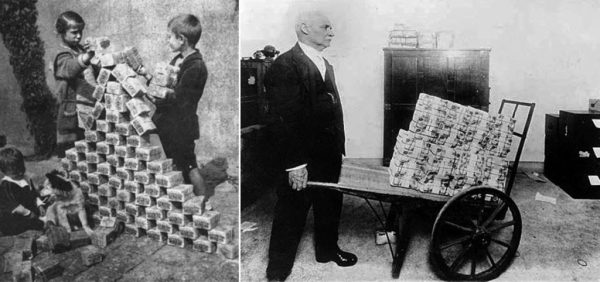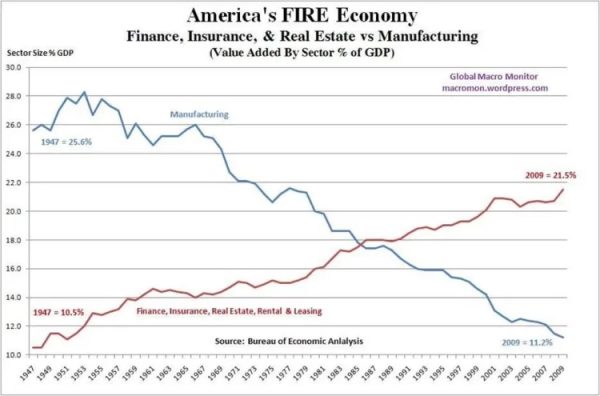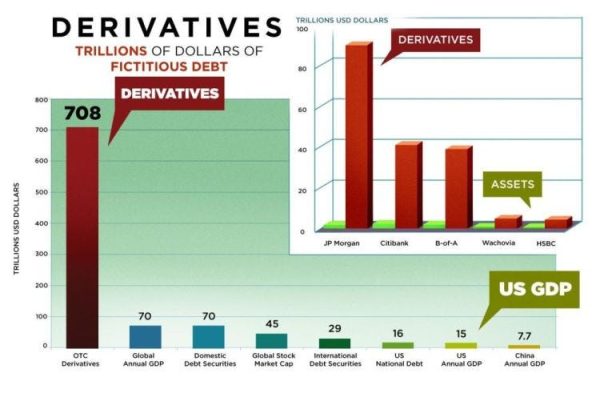As the geniuses running the western financial bubble (sometimes called an “economy”) continue to double down on their obsession to pump a dead financial system with ever more trillions in stimulus spending, arguments are raging among brainwashed economists living in denial over the oncoming systemic collapse.
The failure of Silicon Valley Bank, Signature Bank, and several other financial institutions over the past week has forced the trans-Atlantic system’s oncoming meltdown with idiotic “debates” about how to keep the zombie banks alive just a little bit longer. On the one hand incompetent engineers on the Titanic passionately argue over whether they should accelerate or decelerate the speed of the boat whose hull has long been torn to shreds by an iceberg comes to mind.
Bail-ins are again seriously being discussed as a new form of “response” that can be done in tandem to the long-held practice of bailouts which began infusing trillions of dollars into too-big-to-fail banks.
Figures like U.S. Treasury Secretary Janet Yellen and Fed Chair Jerome Powell championed a new wave of high interests as “a plus for society’s point of view” in order to counteract the increasing rates of inflation sweeping across every sector of the economy. Many monetarist economists have argued that interest rates should be hiked up to 20%, just as they had been in 1980 by then Fed Chairman Paul Volcker, which saw interest rates collapse from 12.5% in 1980 to 3.8% in 1982.
ALL sides however (bail-outers, bail iners and interest hikers) are either completely ignorant or outright liars trying to distract citizens and policy makers from the real systemic nature of the oncoming meltdown that can only be dealt with if certain fundamental facts of recent history are kept in mind.
Why is Inflation going to Skyrocket?
Since a pandemic induced nations to lockdown their economies, rescue packages and unlimited money printing to keep people from literally starving, and banks from collapsing has become a new normal. $24 trillion dollars in COVID related debts have been generated internationally, while U.S. Federal Reserve balance sheets have doubled over the same period to $8 trillion with increasing rates of liquidity injections flushed into the Too-Big-to-Fail banks since September 2019. So far, consumer price inflation has risen by 4.2% in 12 months, but based on the obvious reality of $28 trillion of totally unpayable U.S. debt, sustaining a $1.2 quadrillion derivatives bubble time bomb alongside the breakdown of supply chains and a dysfunctional green infrastructure program pushed by Biden, the runaway threat of inflation and even hyperinflation is firmly (or should be) on everyone’s mind.
Now if loud promoters of “tight money” policy like Deutsche Bank’s Folkerts-Landau or Jerome Powell were talking about the insane money printing disassociated from any systemic restructuring of the over-bloated Too-Big-to-Fail zombie banks or serious recovery program, then he should be applauded for raising the spectre of unbounded inflation. Germany did after all have a direct experience with this disastrous policy back in 1923 when hyperinflation tore the German economy to shreds and set the stage for the rise of Nazism shortly thereafter. (1)
Sadly, both Folkerts-Landau and Powell are instead pushing policies that will not only accelerate an economic meltdown a century after the chaos that ripped Weimar to shreds, but usher in a new central bankers’ dictatorship that had only been subverted in 1933 due to the fortuitous intervention of U.S. President Franklin Roosevelt.
So What Did Volcker Do?
Since economists are told repeatedly that Volcker’s interest rate hikes of 1979-1982 saved the U.S. economy, let’s look at what really happened and why Volcker described his philosophy as a “controlled disintegration”.
While inflation did indeed spread across the USA in the 1970s, it is worth asking: why did this actually happen and did Volcker’s reforms have anything to do with solving that problem? Or did both the problem and its nominal solution drive a singular agenda of controlled destruction of the USA now playing out four decades later?
For one, the shift away from industrial long-term development with the 1971 floating of the U.S. dollar off of the gold reserve standard went a long way to turning a once-forward thinking productive, manufacturing-driven economy into a consumer cult, post-industrial waste. This “post industrial” age was characterized by outsourced industries relying ever more on increased rates of imports of things the USA once made for itself. A FIRE economy (of Finance, Insurance and Real Estate speculation) increasingly took over the once powerful manufacturing sector.
Agro-Industrial production was replaced by service sector jobs as the USA became ever more reliant on cheap imports made from China, Mexico, and other poor nations who were expected to remain labor intensive sweat shops for eternity.
This detachment of the “valuation” of the dollar from all physical measurable standards went a long way to killing the buying power and raising inflation as monetary circulation increased ever more by speculation on oil, currencies or other goods that often had no connection with reality. Investment rates into cutting edge science both in the atomic realm of fusion and the macro realm of space exploration were cut off drastically (see graphs) as general vital infrastructure maintenance and improvement collapsed drastically across all OECD nations trapped in the “new post-industrial normal”.
Non-military related science R & D also saw a collapse during this period from 2.5% of GDP in 1971 to a mere 0.4% of GDP in 2020 (see graph).
Deregulation and market liberalization castrated the role of the sovereign nation state ever more from 1971 onward, as “laissez faire” policies dominated a once-protectionist landscape. Rather than continuing the successful practice of “parity pricing” which defined the real growth of western nations during the 25 post-WW2 years, the markets run by speculators looking only towards maximizing profit defined the prices of goods.
Last but not least, oil price increases of 400% during the 1973 OPEC crisis is admitted to have played a big role driving the 1973-79 inflation, but as researcher William Engdahl demonstrated in his 1992 Century of Oil, then Secretary of State Henry Kissinger had more of a role in manufacturing this crisis from scratch by keeping hundreds of tankers replete with petrol from being unloaded in the USA and facilitating the 400% increase with the assistance of several high level oil ministers in the Middle East beholden to Kissinger. In recent years, Saudi Arabia’s former OPEC minister at the time corroborated Engdahl’s research stating:
“I am 100 per cent sure that the Americans were behind the increase in the price of oil. The oil companies were in in real trouble at that time, they had borrowed a lot of money and they needed a high oil price to save them.”
Putting the Trilateral Commission into Perspective
This shift of the U.S. economy, from its former role as an industrial producer economy to a consumer cult of speculation and monetarism, was accompanied by a broader international shift that was being orchestrated by a cabal of misanthropic technocrats managing an organization known as the Trilateral Commission founded in 1973 by Chase Manhattan President David Rockefeller III and a sociopathic grand strategist named Zbigniew Brzsinski.
The aim of the Trilateral Commission was to destroy the sovereign manufacturing base of both the USA and international developing sector alike.
For anyone who might consider this paranoid “conspiracy theorizing”, it is useful to be reminded that among the highest echelons of the U.S. executive branch under President Carter included members such as Brzezinski, Walter Mondale (Vice President), Harold Brown (Defense Secretary), Cyrus Vance (Secretary of State), Michael Blumenthal (Treasury Secretary), James Schlesinger (Energy Czar) and Paul Volcker himself as Fed Chair. Henry Kissinger was also a leading member of this group.
Among the many goals of the Trilateral Commission laid out by Brzezinski in his 1970 Manifesto “Between Two Ages” was the need to drive the transition of society towards what Brzezinski referred to as the “technetronic era” saying:
“The technetronic era involves the gradual appearance of a more controlled society. Such a society would be dominated by an elite, unrestrained by traditional values. Soon it will be possible to assert almost continuous surveillance over every citizen and maintain up-to-date complete files containing even the most personal information about the citizen. These files will be subject to instantaneous retrieval by the authorities.”
During a 1975 Trilateral Commission study called Crisis in Democracy, overseen by Zbigniew, Clash of Civilizations ideologue Samuel Huntington wrote: “we have come to recognize that there are potential desirable limits to economic growth. There are also potentially desirable limits to the indefinite extension of democracy… a government which lack authority will have little ability to impose on its people the sacrifices that will be necessary”.
So what sort of sacrifices did these Trilateral Commission technocrats think necessary in a healthy society liberated from its foolish belief in scientific and technological progress that animated the policy outlook of such rifraf as Franklin Roosevelt, John F Kennedy, Charles De Gaulle or Bobby Kennedy?
This is where Volcker steps in.
The Meaning of ‘Controlled Disintegration’
In 1978, faced with unbounded inflation, Paul Volcker spoke at a conference at Warwick University London stating that “a controlled disintegration in the world economy is a legitimate object in the 1980s”.
Upon ascending to the chair of the Fed a year later, he wasted no time in applying this program. Not only did he render available credit impossible for many small and medium enterprises by raising interest rates to 20%, Volcker also ensured that third world nations then being sucked back into a neocolonial debt slavery under the IMF and World Bank economic hitmen, would be sucked into ever greater rates of unpayable debts as a new form of slavery. Between 1979-1982, third world debt skyrocketed from 40-70% across the board leading to a major debt crisis.
During this period U.S. agricultural output collapsed, metal cutting machine tools fell by 45%, automobile production fell by 44.3% and steel production fell by 49.4% as bankruptcies skyrocketed leaving only mega-corporations strong enough to pay the draconian rates while absorbing small bankrupted companies and farms like a modern day Borg consuming ever greater rates of cheap labor and cheap resources from poor nations.
To understand how these countries remained poor and exploitable, one need only visit the Malthusian State Department/CIA Report authored by Henry Kissinger in 1974 called NSSM-200 that called for a total depopulation program targeting 14 poor nations then desirous of industrial growth. Those targeted included India, Bangladesh, Pakistan, Indonesia, Thailand, the Philippines, Turkey, Nigeria, Egypt, Ethiopia, Mexico, Colombia, and Brazil. Kissinger’s logic was simple: If these nations develop, their populations will grow. If their populations grow they will use their resources. BUT since it is in the strategic interests of the USA to use those resources, these nations must be kept down.
Nationalist leaders among those target nations who had a different idea were targeted for assassination or regime change throughout the 1980s.
Back in the USA, Paul Volcker additionally took aim at commercial banks by forcing vast increases in reserve requirements making lending additionally difficult (although speculation in investment banks were facilitated with the Garn-St. Germaine Act of 1982). This act and accompanying financial de-regulation during this period of “Reaganomics” led the way to the new age of universal banking beginning with Thatcher’s Big Bang in 1986, the end of Canada’s Four Pillars that same year, and finally, the killing of Glass-Steagall in 1999. The dream of social Darwinists of an unregulated world of each against all where only the strongest and fittest and most sociopathic survive was now real. In the Soviet Union, this process of nation stripping and deregulation that took decades to wreck havoc on western economies was accelerated in the space of a decade of shock therapy. In China, where agents of Soros and the CIA, like Zhao Ziyang (Prime Minister and CCP General Secretary from 1987-89), attempted to impose liberalizing reforms like a Chinese Gorbachev, the rape was luckily stopped before a Russian model could be imposed.
With Glass-Steagall out of the way, commercial and investment banks could unite to form “the ultimate, all-powerful, many-headed financial conglomerate” as outlined by Lord Jacob Rothschild in 1983 (2).
In 2001, as Zbigniew Brzezinski’s Islamicist monstrosity created to fight the Soviets in Afghanistan had been incubated throughout the 1990s, a new program of never-ending wars in the Middle East was launched. While the Middle East was turned inside out under a new age of war, the financial services sector avoided several near blowouts in 1997, 1998, and 2000 (with the collapse of the dot com/Y2K bubble). This was done by deregulating over-the-counter derivatives which turned a $70 trillion time bomb (in 2001) into a $650 trillion time bomb in 2008 when the housing market collapsed.
While opportunities then existed to impose Glass-Steagall and break up the banks as had been done earlier by FDR in 1933, hyperinflationary money printing was chosen instead resulting in another 12 years of insanity as the bubble continued to expand and the physical economic productive base continued to atrophy.
Today, we sit on not one bubble concentrated in housing prices, or oil, or currencies, but rather a multitude of bubbles in literally everything from commodities, bitcoin, housing, commercial real estate, bundled student debts, automotive loans, and the over-valued U.S. currency itself.
The COVID Plandemic did not “cause” the current systemic crisis as many fools have parroted for over a year, but has merely served as cover to obscure the real systemic causes of the long-awaited collapse and accelerate the controlled disintegration of the system as the world is prepared to transition into a “new technetronic age” which has come to be dubbed a “Great Reset” or “Fourth Industrial Revolution”.
We are told by the likes of Klaus Schwab, or World Economic Forum trustees Mark Carney, Christine Lagarde, and Chrystia Freeland that the age of free market capitalism which reined from 1971-2020 has come to an end, and that a new epoch of “green finance” under a decarbonizing world is upon us. Under this new world order of “stakeholder capitalism” citizens will learn to own nothing and be happy, while polluting companies who commit climate sins will be choked of all credit.
As former Bank of England head Mark Carney recently wrote of the new age of “net zero” in his new book Values Building a Better World for All, (which many have recognized as a precursor to his replacement for Canada’s Justin Trudeau as Prime Minister):
“It could be generations before the gains of the fourth industrial revolution are widely shared. In the interim, there could be a long period of technological unemployment sharply rising inequalities and intensifying social unrest”.
Klaus Schwab has publicly fantasized of this new age of human-machine merging of microchipped brains interfacing with the global net, and Tony Blair has giddily said that “vaccination is, in the end, going to be your route to liberty”.
So, while that story might sound a tad bleak, there remains only a tiny obstacle to the successful implementation of this anti-human program.
This obstacle is located in the Greater Eurasian Partnership led by Russia and China and joined by 135 nations of the world that have signed onto the Belt and Road Initiative. These are nations who would rather have a multipolar future vectored around large scale industrial growth than be sacrificed on the alter of Gaia by a technocratic neo-Malthusian priesthood. This multipolar paradigm operates under a financial and geopolitical philosophy at total odds with the closed, entropic obsession of the forces associated with Kissinger, Blair, Carney or Schwab, and some see this as a good thing not only for the Eurasian world, but for nationalist forces within the West as well.
Footnotes
(1) In June 1922, 300 marks exchanged $1 US and in November 1923, it took 42 trillion marks to get $1 US! Images are still available of Germans pushing wheel barrows of cash down the street, just to buy a stick of butter and bread (1Kg of Bread sold for $428 billion marks in 1923). With the currency’s loss of value, industrial output fell by 50%, unemployment rose to over 30% and food intake collapsed by over half of pre-war levels.
(2) In his 1983 speech, Lord Jacob Rothschild stated: “two broad types of giant institutions, the worldwide financial service company and the international commercial bank with a global trading competence, may converge to form the ultimate, all-powerful, many-headed financial conglomerate.”
Related posts:
Views: 0
 RSS Feed
RSS Feed
















 March 18th, 2023
March 18th, 2023  Awake Goy
Awake Goy 






 Posted in
Posted in  Tags:
Tags: 
















